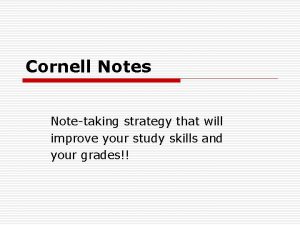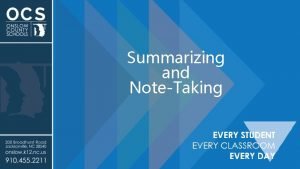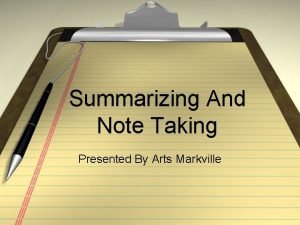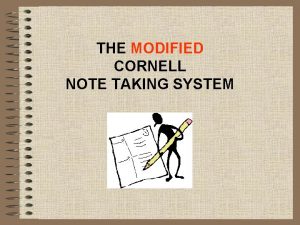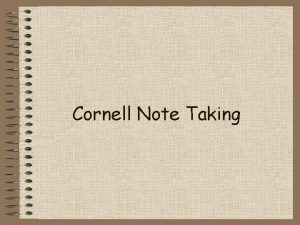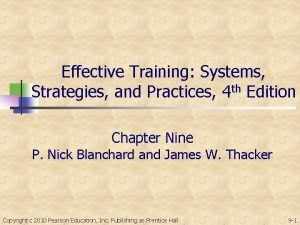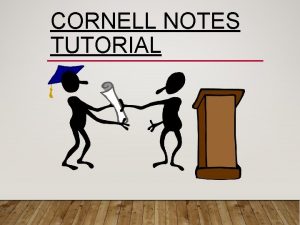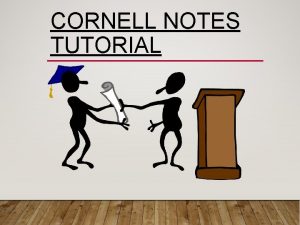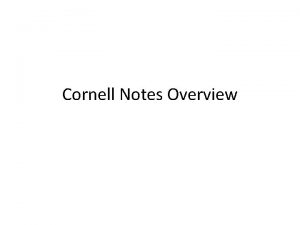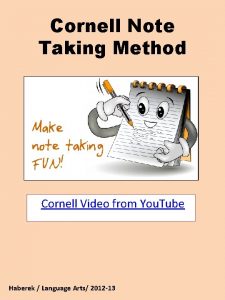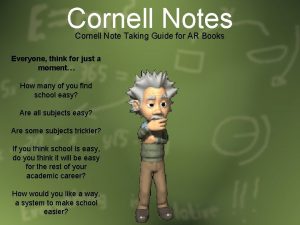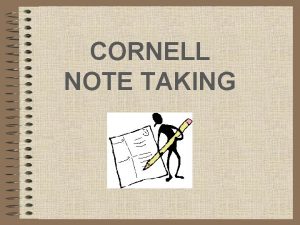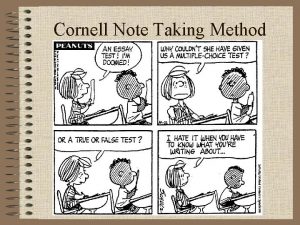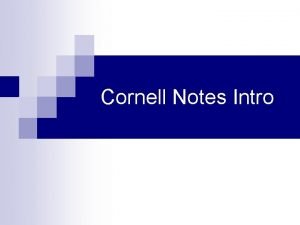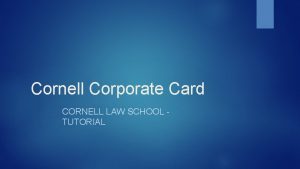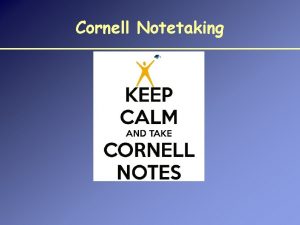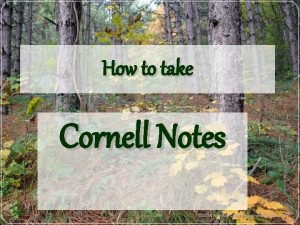EFFECTIVE NOTE TAKING STRATEGIES Cornell Note Taking System














- Slides: 14

EFFECTIVE NOTE TAKING STRATEGIES: Cornell Note Taking System & Learning Log

Lesson Objective l The student will learn how to properly record notes and utilize both the Cornell Note Taking System and the Learning Log.

Bellwork! ? ? ? Have you ever tried to take notes and then had a difficult time understanding them at a later date? If so, describe your experience.

Terminology l Cornell Note Taking System – l The Cornell method provides a systematic format for condensing and organizing notes. Learning Log – This technique is used to help with focusing on what is learned in class by writing thoughts, reactions, and responses to class lectures, videos, or discussions.

Part 1 Part 2 Part 3 4 t r a P Part 5

The 5 Parts of Cornell Notes l Part 1: Heading – l l Part 2: Topic Part 3: Notes – l Record the lecture here Part 4: Questions/Cues – l Your name, date, class/subject, and topic Main ideas, questions that connect the points, diagrams, and prompts Part 5: Summary – Summarize main idea for quick reference after class during review

The Five (5) Steps Stated on the “Notes” Section STEP #1 - RECORD l l Listen and write your notes using concise sentences Use shorthand symbols, abbreviations, or lists Skip a space between points for easy reading

The Five (5) Steps Stated on the “Notes” Section contd… STEP #2 - QUESTIONS l l l Develop questions either during the lecture or immediately after class Questions help clarify meanings or any misunderstandings Strengthens memory

The Five (5) Steps Stated on the “Notes” Section contd… STEP #3 - RECITE l Cover the “Notes” column with a sheet of paper or fold it over Then, looking at the questions in the “Cue” column only, say aloud in your own words, the answers to the questions or main ideas

The Five (5) Steps Stated on the “Notes” Section contd… STEP #4 - REFLECT l REFLECT Ask yourself—“What’s the ‘BIG PICTURE’ and how can I TIE everything together? ”

The Five (5) Steps Stated on the “Notes” Section contd… STEP #5 - REVIEW l Spend at least 10 minutes every week reviewing all of your previous notes. By doing the above, you will retain a lot of knowledge for the exam!

Active Participation l l l (1) Reflect on what was learned during 1 st hour and record in Learning Log. (2) Using your copy of the Cornell Notes, label and circle the five parts involved in this note taking process. (complete during lecture) (3) Record 5 steps of “Notes” from the Power point on their Cornell Notes copy, under the section, “Notes”. (complete during lecture) (4) Independently, formulate and write questions in the “Questions” column. Analyze the information and develop a summary based on the lecture, “Plotting Points. ” (5) Discuss with a partner the questions that you developed.

CLOSURE-CORNELL NOTE TAKING l Teacher calls on non-volunteers to share with the class one item that is entered under the “Questions/Cue, ” “Notes” and “Summary” columns; teacher assesses and provides feedback.

Ticket-out-the-Door l Students demonstrate the completion of the Cornell Notes page, which includes: – – Labeled parts Notes Questions Summary. * Based on “Plotting Points” Lesson
 Note taking 101
Note taking 101 Cornell note taking strategy
Cornell note taking strategy Cornell note taking strategy
Cornell note taking strategy Effective note-taking methods
Effective note-taking methods Summarizing and note taking strategies
Summarizing and note taking strategies Summarizing and note taking strategies
Summarizing and note taking strategies Difference between note making and note taking
Difference between note making and note taking Signal words example sentences
Signal words example sentences Difference between note making and note taking
Difference between note making and note taking Note taking definition
Note taking definition Note taking legend
Note taking legend Cornell notes setup
Cornell notes setup Effective training systems strategies and practices
Effective training systems strategies and practices 10 effective dap teaching strategies
10 effective dap teaching strategies Define the relationship ch 6
Define the relationship ch 6

